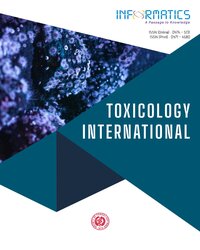Protective Effects Of Melatonin Against 2,4-dichlorophenoxyacetic Acid Induced Altered Haematological Variables In Mice: An In Vivo And In Silico Approach
Subscribe/Renew Journal
2,4-Dichlorophenoxyacetic acid (2,4-D) is a systemic phenoxy herbicide that induces oxidative stress. In contrast, melatonin is a secretory product of the pineal gland with antioxidant properties. In the present study, the ameliorative potential of melatonin (10 mg/kg body weight) was investigated against 2,4-D (low, mid, and high dose-16.5, 33.0, and 66.0 mg/kg body weight) induced altered haematological variables using in vivo and in silico models. Doses of 2,4-D and melatonin were administered orally for 28 days. The evaluated haematological indices in the present study were Haemoglobin (Hb), Red Blood Corpuscles (RBC), Haematocrit (HCT), Mean Corpuscular Volume (MCV), Mean Corpuscular Haemoglobin (MCH), Mean Corpuscular Haemoglobin Concentration (MCHC), White Blood Corpuscles (WBC), Lymphocytes, Monocytes, Granulocytes, Platelet Count (PT), Mean Platelet Volume (MPV), Plateletcrit (PCT), and Erythrocyte Sedimentation Rate (ESR). The statistical significant value was considered at p<0.05. Molecular docking study was performed for interaction of 2,4-D and melatonin with haemoglobin. In vivo results revealed that 2,4-D treatment showed a significant dose-dependent alteration in above all studied haematological indices. No significant auto reversal effects were observed in the withdrawal study, on the contrarily, the altered haematological indices were normalized and comparable to control when melatonin was given alone and in combination with 2,4-D. In silico results also demonstrated that 2,4-D and melatonin showed competitive bindings with haemoglobin. In nutshell, these in vivo and in silico findings depicted those haematological indices were altered by 2,4-D toxicity and can be abridged by melatonin attributed to its ameliorative potential as also evidenced by molecular docking.
Keywords
2,4-dichlorophenoxyacetic Acid, Haematotoxicity, Melatonin, Mice, Protection.
User
Subscription
Login to verify subscription
Font Size
Information



